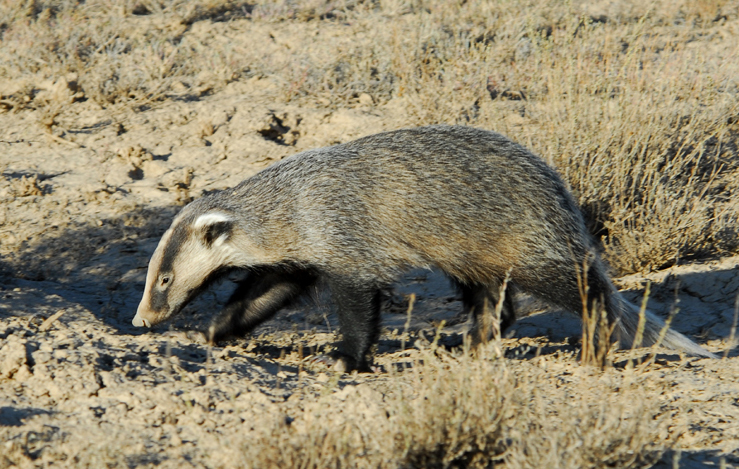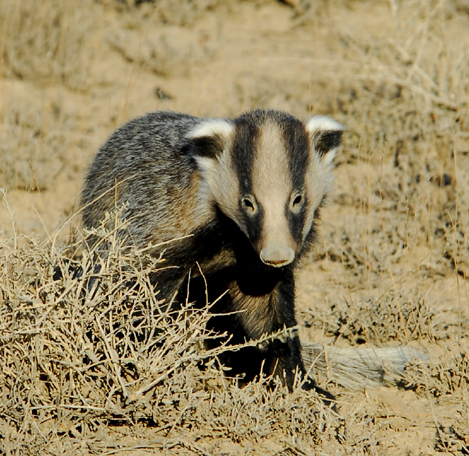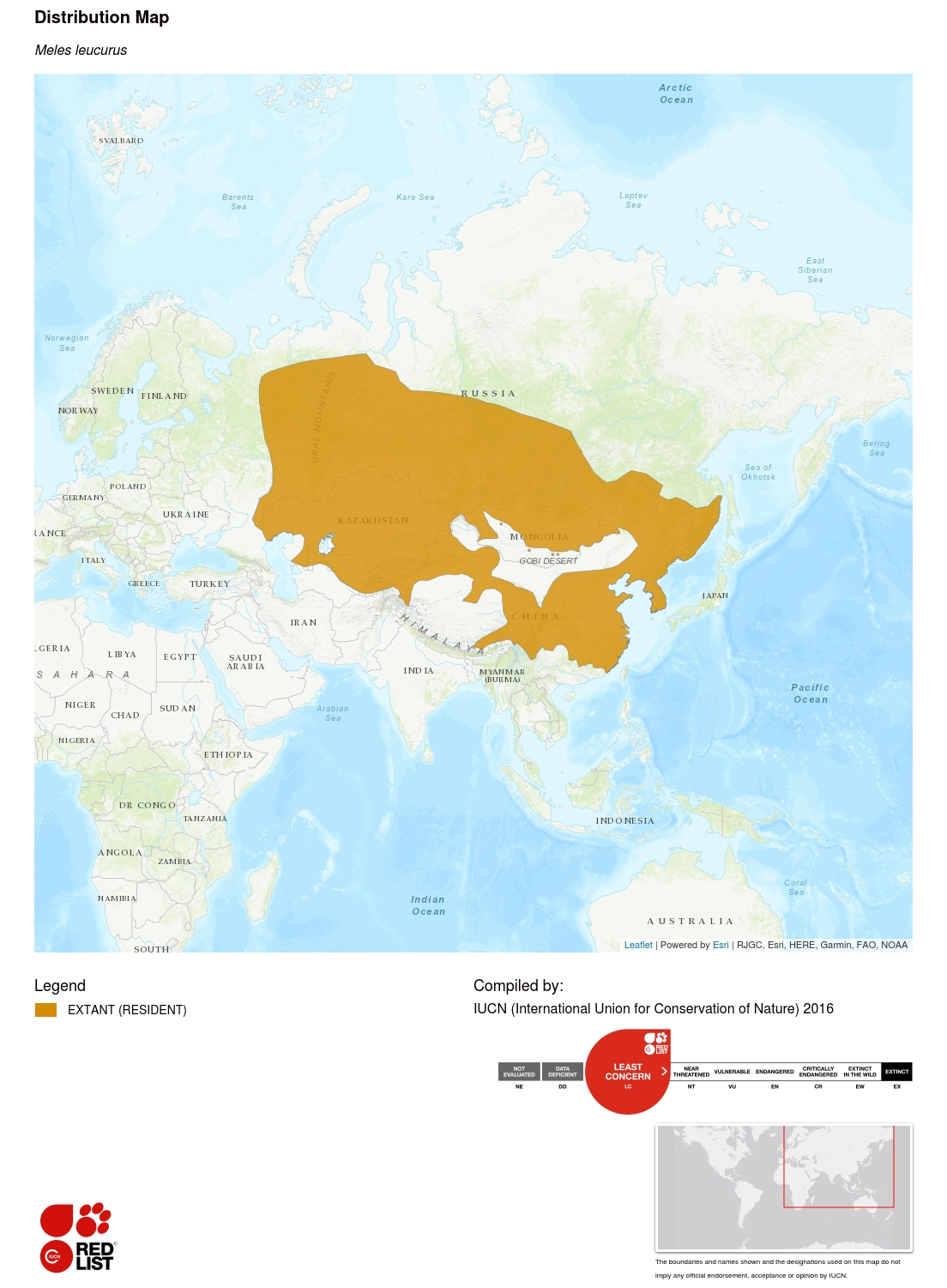狗獾Asian Badger
1. 分类Taxonomy(IUCN)
食肉目Carnivora
狗獾属Meles
狗獾Meles leucurus(Hodgson,1847),英文名Asian Badger
2. 保护级别Conservation Assessment
l 我国三有物种,指有益的、有重要生态价值、有科学研究价值的野生动物
Beneficial, ecologically important and scientifically valuable wildlife of China
l IUCN红色名录低危物种
Least Concerned species on IUCN Red List
3. 形态特征Physical Description
狗獾体长50-90厘米,尾长11.5-20.5厘米,体重3.5-17千克。
身体矮壮,尾短。颈部粗短,四肢短健,前后足的趾均具粗而长的黑棕色爪,前足的爪较后足长,利于挖掘。肛门附近具腺囊,分泌臭液。长有圆锥形的头部和突出的吻鼻部。狗獾的喉、颈、胸、腹和四肢均为黑色。背部及体侧毛色呈沙黄至灰白。狗獾裸露的鼻部为黑色,且鼻子与上唇之间非裸露,覆有短毛。同时,狗獾具有独特的面部斑纹,具有窄长的黑色贯眼纵纹,使得其脸颊显得比猪獾更白净(图1、2)。部分狗獾个体的背部和体侧的毛色较淡,甚至呈现出整体近白的形态。
The badger is 50-90 cm long, with a tail 11.5-20.5 cm long and a weight of 3.5-17 kg.
Badger has a stocky body, short tail, thick and short neck, short and strong limbs. The toes of the front and back feet are with black-brown, thick and long claws, and the claws of the front feet are longer than that of the back feet, which is conducive to digging. Near the anus there is a gland sac, secreting smelly fluid. It has a conical head and a protruding snout. The badger's throat, neck, chest, abdomen and limbs are black. Hair on back and body side is sand yellow to gray. The badger's bare nose is black, and the part between the nose and the upper lip is covered with short hair. Badger has a distinctive facial pattern, with long, narrow black transverse stripes through eyes that make its cheeks appear whiter than those of the hog-nosed badger (Fig. 1, 2). Some badgers show a relatively light fur color on the back and sides, and some even shows a nearly whole white body coloration.

图1. 狗獾实体图(作者David Blank,来源Animal Diversity Web)
Figure 1. Badger (contributor: David Blank, origin: Animal Diversity Web )

图2. 狗獾面部示意图(作者David Blank,来源Animal Diversity Web)
Figure 2. The face of badger (contributor: David Blank ; origin: Animal Diversity Web)
4. 地理分布
狗獾的分布区包括东亚的大片区域,并向东西方向延伸至中亚与远东,包括俄罗斯、中国、蒙古、朝鲜半岛、哈萨克斯坦、乌兹别克斯坦(图3)。
在中国,狗獾广泛分布于从东北经华北至华东、华中、西南(大横断山地区)、青藏高原东部与北部以及西北新疆中部和西部的广大地区,见于除台湾和海南以外的大陆各省区。
The range of the badger covers a large area of East Asia and extends east-west into Central Asia and the Far East, including Russia, China, Mongolia, the Korean Peninsula, Kazakhstan and Uzbekistan (Fig. 3).
In China, the badger is widely distributed from the northeast and north areas to east, central area, southwest (Hengduan Mountain area), eastern and northern Qinghai-Tibet Plateau, central and northwest Xinjiang and western area. It is found in all provinces and regions of the mainland except Taiwan and Hainan.

图3. 狗獾世界范围地理分布图(来源IUCN)
Figure 3. Geographic range of Asian badger around the world (origin: IUCN)
5. 栖息环境Habitat
狗獾既可在森林也可在开阔生境中栖息,见于落叶林、混交林和针叶林、有河流的生境、农业地、草地草原和半荒漠地区。有时可见于郊野地区。
Badges can inhabit both forests and open areas, including deciduous forest, mixed forest, coniferous forest, habitat with river, agricultural land, grassland and semi-desert. It is sometimes found in the suburb area.
6. 生活习性Ecology
狗獾喜欢集中在一处排粪。观察发现,狗獾通常会选择较为平坦、植被较少的地面排粪。在排粪前挖坑,数日内将粪便排在同一个坑内,从而形成粪堆。一般认为,粪堆起着标记领域的作用。
由于狗獾通常在夜间活动,视力较差,嗅觉是收集信息的主要方式。
Badger likes to excrete in a “public toilet”. They are observed to often choose a flat, less vegetated site. Before excreting, they will dig a pit and use it for a few days, forming a dung heap. It is generally believed that the dung heaps act as marks for territory.
Because the badgers usually are active at night, their eyesight is poor, and their smell is the main way to collect information.
6.1 食物Food Habits
狗獾是杂食性动物,食性广泛,其中动物性食物多于植物性食物。食物包括昆虫、蚯蚓等无脊椎动物、爬行类、两栖类、鼠兔和啮齿类等小型兽类、植物根茎、大型真菌等。
Badgers are omnivorous animals that forage a wide range of food, among which there are more animal food than plant-based food. Their food includes insects, invertebrates (e.g., earthworms), reptiles, amphibians, rabbits and rodents, roots, and large fungi.
6.2 社群Sociality
它们通常以家庭群为单位群居生活,在地下挖掘具有多个洞室的复杂洞穴系统,一个家庭群通常由一个雌性首领、一个雄性首领和数十头狗獾构成。
They usually live in groups of families, digging complex underground burrow systems with multiple chambers. A family group usually consists of one alpha female, one alpha male and dozens of other badgers.
6.3 领域Home Range
狗獾具有领域性,其社群生活的区域称之为家域。通常同一社群的狗獾在同一家域中觅食,只有在家域中的食物短缺的情况下,才会发生种内竞争,竞争的结果通常是造成年幼或等级地位低的狗獾被迫离开家族领域并寻找新的栖息地。每个狗獾家族占有一个家域,家域中会有一个或多个洞穴以及数个觅食地,彼此之间有兽径相联接。
狗獾营穴居生活,它们一生中几乎一半的时间是在洞穴内度过的。它们需要花费大量时间和能量营造洞穴作为睡眠、栖息、繁殖和躲避天敌的场所,因此洞穴对狗獾的生存是极为必要的。獾洞既不易被别的动物占据,也不易被同类其它家族社群成员所占据。通常洞穴较大,距离地面2-3米,洞的直径约0.5米,长约10米,洞穴有很多入口、通道和房间。
Badgers are territorial, and the area the group live is called home range. Badgers in the same social group usually forage in the same home range, and intraspecial competition occurs only when food is scarce. The result of competition is usually that young or low-ranking badgers are forced to leave the family territory and seek new habitats. Each family of badgers occupies a home range with one or more burrows and feeding grounds connected by paths.
Badgers live in burrows and spend almost half their lives in caves. They spend a lot of time and energy building burrows as a place to sleep, roost, breed and hide from predators, so burrows are essential to their survival. Badger burrows are not easily occupied either by other animals or by members of other family groups of the same species. Usually the cave is large, 2-3 meters above the ground, with a diameter about 0.5 meters and a length about 10 meters. The cave has many entrances, passageways and rooms.
6.4 节律Rhythm
狗獾夜间出洞活动觅食,白天躲藏在洞穴里。观察表明,狗獾在凌晨4-5点和黄昏18点最活跃。成年雌雄狗獾的活动节律无明显差异,但它们和亚成体狗獾之间存在显著差异。亚成体活动时间比成体平均少两小时左右。
The badgers go out of burrows and forage at night, and hide in the cave during the day. It’s observed that the badgers are most active at 4:00-5:00 in the morning and 18:00 at dusk. There is no significant difference in the rhythm of the adult male and female badgers, but there is between them and the sub-adults. Sub-adults’ active time is about two hours less than the adults.
6.5 移动Moving Method
狗獾足趾类型为半跖行性,具有5趾,行走时左后足与左前足重叠,右后足与右前足重叠。雨后的以及在泥地或雪地上留下足迹或足迹链通常更为明显。
The badger's toes are half plantar, with five toes. When walking, the left hind foot overlaps with the left forefoot, and the right hind foot overlaps with the right forefoot. Footprints left after rain, in mud or snow are usually more obvious.
7. 繁殖Reproduction
狗獾一般2年性成熟,但在食物丰富的地区雌性可能成熟早一些。狗獾在冬季12月至1月初交配,雌兽每年产1胎,窝仔数1-5只,平均2-3只。
Badgers generally reach sexual maturity at 2 years old,‚but females may mature earlier in areas where food is abundant. Badgers mate from December to early January in winter, and the female gives birth to one litter every year, with a litter size of 1-5 and an average of 2-3.
8. 生态系统中作用Ecosystem Role
狗獾为捕食者,消耗了生态系统的次级生产力,在生态系统中处于次级消费者的地位。狗獾对于维系生态系统的平衡与稳定,以及物种多样性具有十分重要的意义。
狗獾营洞巢生活,迁移能力弱,一旦洞巢被破坏,它们就无法生存。和鸟类和其他动物不一样,即使栖息地恢复以后,它们也很难得到恢复。而且目前狗獾的野外种群数量还在不断地减少,如果不及时的加以保护,狗獾可能会在很多地区绝迹。因此,保护好狗獾不仅是维持地区生态系统的正常运转的要求,而且是保护好全球生物多样性的完整性的重要任务。
As predators, badgers consume the secondary productivity of the ecosystem and act as secondary consumers in the ecosystem. Badgers play an important role in maintaining ecosystem balance and stability, as well as species diversity.
Badgers live in caves and are weak in migration. Once the caves are destroyed, they cannot survive. Unlike birds and other animals, they have a hard time recovering even after their habitat has been restored. And the current wild population number of badgers is still declining, if not timely protection, badgers may become extinct in many areas. Therefore, the protection of badger is not only a requirement to maintain the normal operation of regional ecosystem, but also an important task to protect the integrity of global biodiversity.